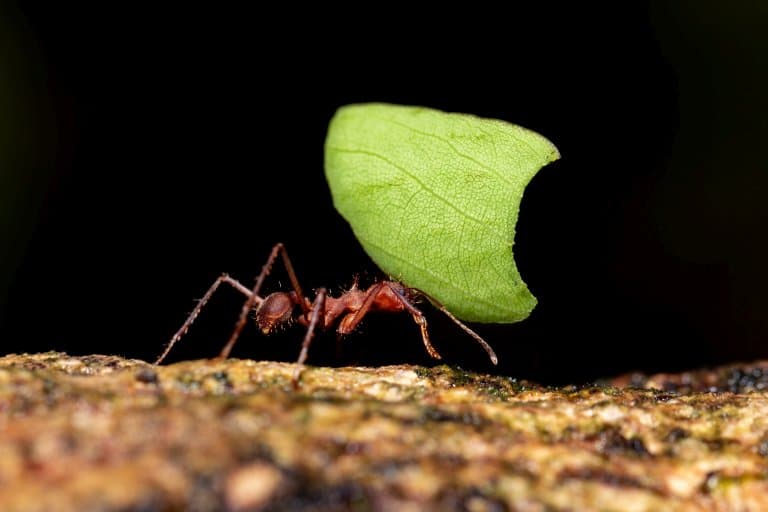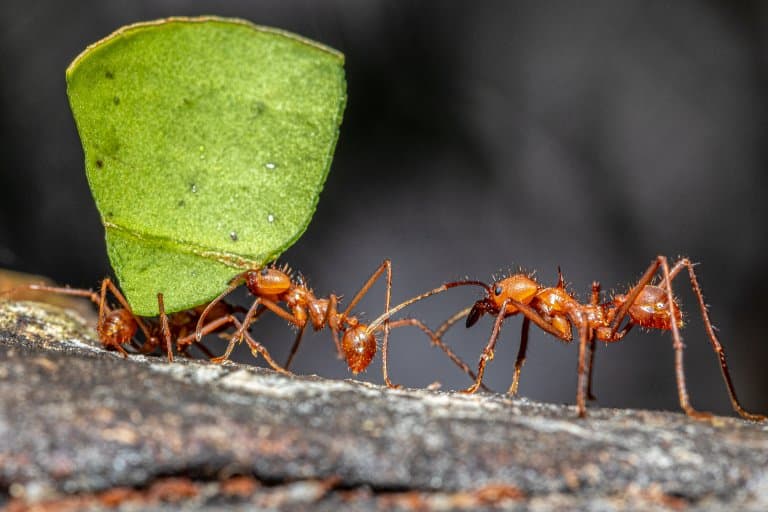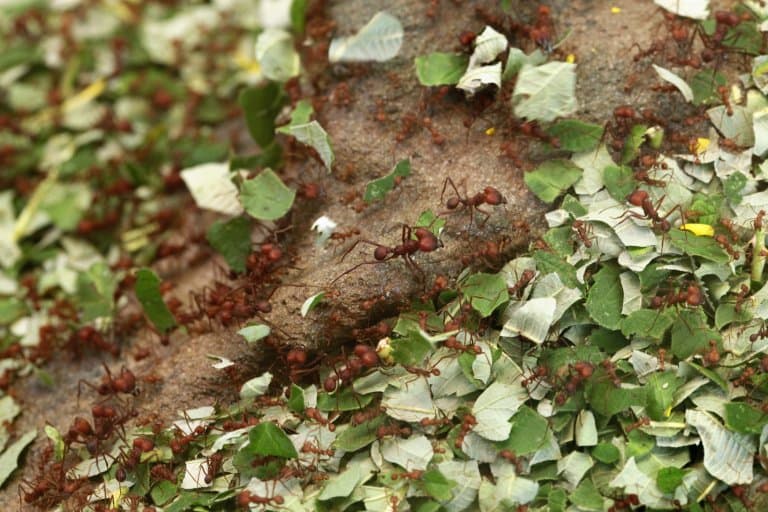Leafcutter Ant Profile
Between the ever-moving goalposts in the quest to separate ourselves from the rest of the Kingdom, we’ve been continually discouraged by the discovery that we’re not the only ones to speak, use tools, dream, become self-aware, express complex thoughts, or even appreciate music.
“But surely, we are the only species to develop agriculture, or domesticate other organisms, right? At least give us that. We have to be special somehow!”
Sorry, humans, wrong again. Ants have been doing both for tens of millions of years longer than you’ve existed.
Leafcutter ants are 49 different species of leaf-chewing ants from two different genera – Atta, and Acromyrmex. They are known as fungus-growing ants, native to South and Central America.

Leafcutter Ant Facts Overview
| Habitat: | Tropical, subtropical forested areas |
| Location: | South and Central America |
| Lifespan: | Queens can live up to 20 years; workers up to 2 |
| Size: | Up to 16mm (0.6 inches) |
| Weight: | <1g |
| Colour: | Brown or reddish-brown |
| Diet: | Fungus |
| Predators: | Phorid flies |
| Top Speed: | Not recorded |
| No. of Species: | 49+ |
| Conservation Status: | Not Listed |
Leafcutter ants are the most significant herbivores in the Neotropics, with colonies of over eight million and foraging parties that number hundreds of thousands.
These foragers cut and carry foliage from around 15% of the plants in their vicinity, carrying them into special chambers in the earth where they’re protected and nourished as food for a mutualist fungus.
This domesticated fungus is the product of tens of millions of years of agricultural practices and represents yet another blow to the ego of the naked ape.
Interesting Leafcutter Ant Facts
1. They can talk through the ground
Like termites, leafcutter ants have developed a vibration-based communication system that sends signals through the Earth between individual ants.
While termites do this by smacking their enormous faces on the ground, leafcutter species tend to use a more classic form of stridulation, whereby two parts of its body are rubbed together.
This produces an audible sound that we can pick up through the air, but the communication between the ants runs through the ground and is at a frequency we can’t pick up.
One of the main purposes for this call is a distress signal, and when it’s released, other workers rush to the rescue.
But other contexts include foraging and nest building, suggesting there is a diverse repertoire of communications between workers. These signals are combined with chemical cues to produce a complex network of communication within the colony. 1

2. They don’t eat the leaves
Another way these ants demonstrate advanced behavioural characteristics is in their agricultural practices. It’s thought that humans stopped wandering about aimlessly and started growing their own food about 10,000 to 15,000 years ago, but these ants have been doing it for 60,000,000 years.
These ants will send out gathering parties to cut and collect leaves.
They do this not to eat the leaves, but to bury them in special chambers, where they will cultivate a specific fungus. This is the food source of the ant, and it will be dutifully produced and maintained by the 50-million-strong colony over its lifetime.
This process is so significant in the ecosystem that the ants are one of the most ecologically dominant species in the Neotropics.
And for 60 million years, they’ve been doing it sustainably and without destroying the climate. 2 3
3. Leafcutter ants can carry fifty times their body weight
Leafcutter ants will cut and process leaves, flowers, and grasses to help cultivate their fungus.
Their jaws are specially adapted to cutting and ‘sawing’ leaves – and can vibrate up to 1,000 times a second to slice through vegetation.
Incredibly, these leaves can be x50 the ant’s body weight, and they’ll be brought back in lines of ants hundreds of meters long. These foraging parties can include hundreds of thousands of ants.
Relative to their size, they are one of the world’s strongest animals.
4. They’re hugely impactful in their ecosystems
In fact, leafcutter ant agriculture is hugely beneficial to the environment. A mature colony of leafcutters is a superorganism that’s highly specialised to what it does.
In the ocean, sperm whales dive to great depths to eat squid, bringing their nitrogenous wastes up into the shallower waters and recycling nutrients to the photic later. Similarly, but in reverse, leafcutters mix nutrient-poor soil from the depths with the rich organic layer closer to the surface and reduce soil density in the nest-building process. This redistributes carbon and nitrogen into the soils and helps to incorporate more air, too.
These ants are so prolific that they make up a quarter of all herbivory in their ecosystems. The fungus that grows on the leaves transfers nutrients from the fresh organic matter into food for the ants, and combines with root fungi from surrounding plants to enhance nutrient turnover even more.
Ant respiration and waste breakdown further contributes to organic processes within the soils, creating biochemical hotspots where the nests are built.
Finally, the clearing in the forest created by the colonies allows light and air to reach the surface, creating differences in temperature and photosynthesis that help increase biodiversity.
Leafcutter ants are true ecosystem engineers and they are a testament to sustainable agriculture. Much of their success as such can be put down to the way they distribute labour. 4
5. They have four worker morphs
And each sounds like characters from Despicable Me. Leafcutter ant colonies are highly specialised, dividing up the colony into four castes, denoted by their size.
- The smallest, the Minims, are the nurses and carers of the colony. These tiny ants do the cleaning and look after the larvae. They also help break down the leaves into palatable chunks for the fungus gardens.
- Next, the minors, not to be confused with miners, are guard ants, and the first line of infantry when defending the colony. There are huge numbers of these morphs, and their role is to protect the foraging lines.
- Mediae are the ones most commonly seen cutting and carrying leaf fragments. They’re the ones who make up the foraging parties and do a lot of the heavy lifting.
- But the strongest of them all are the Majors. These are the muscle of the colony, and as such do the body of the colony protection and a lot of the heavy lifting when it comes to clearing a path for the Mediae. They’ll fill multiple roles around the colony, usually taking part in anything that requires some brute strength.
This well-oiled machine is what makes the ants so successful, and they’ve been at it for so long, they have developed an evolutionary relationship to their food sources. 5
6. Their colonies can have 8 million ants
In just a few years, the main area of their underground nests can grow to more than 30m (98 ft) in size!
Combined with smaller chambers of the nest, they can reach 600 m2 (6,460 sqft) and contain over 8 million leafcutter ants.

7. Setting up new colonies is difficult
Winged ants will leave existing nests to form new colonies. Females will mate with multiple males to collect the 300 million sperm she needs to set up a new colony.
When a suitable underground lair has been identified, females will land and lose their wings and proceed to start her own fungus garden.
The success rate of queens attempting to start their own successful colony is incredibly low.
8. They have a symbiotic relationship with a mushroom
The fungus the ants farm is within the Lepiotaceae family. This organism relies entirely on the ant for its continued existence, and the ant is equally indebted to the fungus.
Ants will feed and protect the growing organism, keeping it free from pests, and paying attention to its likes and dislikes. If a fungus reacts badly to one food source, the ants will bring it a better one.
But there’s another layer to this complex interaction. A bacterium that grows on the ants also has a symbiotic relationship with them and produces nutrients that help the fungus grow.
So reliant is the fungus on the ants that it has lost its ability to produce spores. This is an entirely domesticated organism, produced purely through ant-selection over 30 million years, long before humans even existed.
To put this in perspective, humans and chimps shared an ancestor between 5 and 10 million years ago. These ants had domesticated their fungal livestock 15 million years ago, around the point that the great apes family emerged. 6

9. They are experts in sanitation
Leafcutter ants have other institutions that put ours to shame, too. Waste management in a leafcutter colony is a complex system of interconnected processes from the ventilation of the nest to the removal and decomposition of waste.
Maintaining the cleanliness of the colony is imperative to the survival of the ants, as parasitic fungal species are always ready to take over if things get too messy.
Older ants are responsible for this dangerous task, as their death represents less of a loss to the functionality of the colony, and so can be more easily tolerated.
Used substrate, discarded fungus, and other trash get transported by the ants to a compost pile outside and downhill of the colony, where it is aerated, rotated and generally managed to encourage decomposition.
The downward positioning of the waste pile prevents rain from washing it back towards the nest, and ant pathways will even be organised into a route that prevents waste from being traipsed back all over the carpets.
Another symbiont of the ants is a bacterium that lives in their glands and produces anti-microbial compounds that help sanitise the colony. Dead ants are therefore placed around the perimeter of the rubbish pile, creating a protective field of these antimicrobials and sectioning the waste from the rest of the nest. 7
10. This can be used against them
In areas where these colonies invade and damage human crops, their hyper-cleanliness can be used as a way to deter them.
Collecting the waste piles from the nests and sprinkling them among the crops can create a no-go zone and prevent foragers from venturing into farmers’ fields. 8
Leafcutter Ant Fact-File Summary
Scientific Classification
| Kingdom: | Animalia |
| Phylum: | Arthropoda |
| Class: | Insecta |
| Order: | Hymenoptera |
| Family: | Formicidae |
| Subfamily: | Myrmicinae |
| Tribe: | Attini |
| Genera: | Atta, Acromyrmex |
Fact Sources & References
- H Markl (1965), “Stridulation in Leaf-Cutting Ants”, NIH.
- Felix A. Hager (2017), “Directional vibration sensing in the leafcutter ant Atta sexdens”, PubMed Central.
- Alexander N. Banks (2003), “Orientation by magnetic field in leaf-cutter ants, Atta colombica (Hymenoptera: Formicidae)”, Wiley Onine Library.
- Amanda C. Swanson (2019), “Welcome to the Atta world: A framework for understanding the effects of leaf-cutter ants on ecosystem functions”, British Ecological Society.
- Laurel (2013), “The Complex Caste System of Leafcutter Ants”, Rice University Insect Biology Blog.
- S. A. Ballari (2006), “Refuse dumps of leaf-cutting ants as a deterrent for ant herbivory: does refuse age matter?”, Wiley Online Library.
- Adam G. Hart (2002), “Waste management in the leaf-cutting ant Atta colombica”, Oxford Academic.
- S. A. Ballari (2006), “Refuse dumps of leaf-cutting ants as a deterrent for ant herbivory: does refuse age matter?”, Wiley Online Library.
